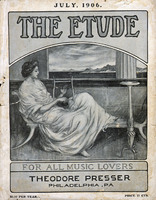It has frequently been objected, and with much justice, that it is barbarous to make young children practice for any length of time on the piano. In general, practicing ends in exhausting the child both physically and mentally. If, however, it is desired to have the child study the piano, practice is necessary, and as far as possible this requirement should be met. These considerations are the basis of an article by Prof. Zabludowski in a recent number of the Blätter für Volksgesundheitspflege of Berlin.
Prof. Zabludowski says that his efforts to improve the conditions under which piano practicing is performed, began when he saw that “violin players succeed much more quickly than piano players in adjusting their hands to the instrument, and also that certain fingers of violin players—if they begin early enough—are lengthened. This is especially true for the index and middle fingers of the left hand, which lengthen considerably.
“I was soon convinced,” continues Prof. Zabludowski, “that the many cases of ‘over-playing of the hand’ to piano players are entirely due to the abnormal relations between the hand of the performer and the instrument. The young violin player, with small hands, has a violin of corresponding dimensions; that is, one-half to three-quarters the usual size. In the case of the piano, however, the keyboard is practically the same on all instruments. We see little children playing on the keyboards that are used by adults.
“Therefore, I decided to build pianos for children, which should only differ from the ordinary instrument in that they had a smaller keyboard. For this purpose it is sufficient to reduce the key from the usual width of 22.5 millimeters, and the whole octave from 19 centimeters to 17 centimeters. In addition it is necessary to so construct the instrument that on the same piano the keyboard for adults and children may be easily interchanged.”
Prof. Zabludowski says that his piano “has two keyboards. They differ from each other only in size; the technic of playing the instrument remains absolutely the same. Thus we obtain a universal keyboard, and simply by turning the keyboard frame one may place in position the larger or smaller board. And we have in addition a certain advantage over the violin as it is not necessary to have two instruments. The new arrangement makes possible an early start at piano playing, as there is no straining or exhausting of the fingers.”



